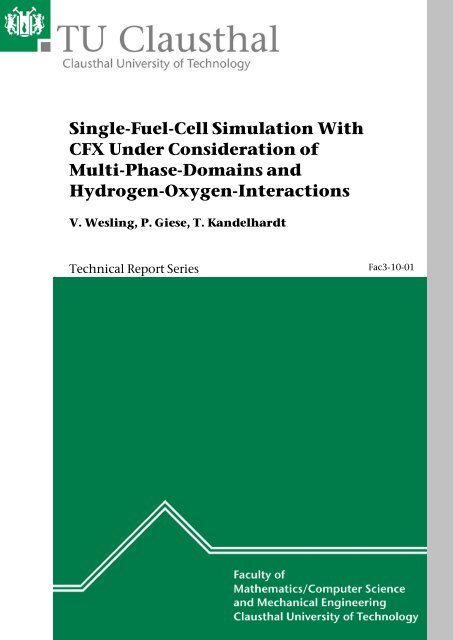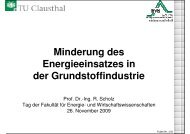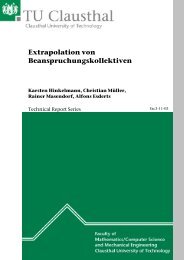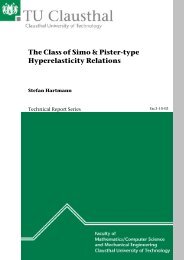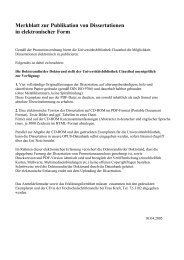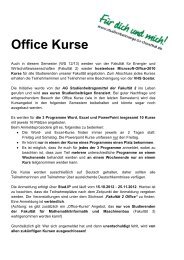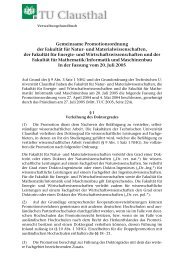Technical Report - TU Clausthal
Technical Report - TU Clausthal
Technical Report - TU Clausthal
You also want an ePaper? Increase the reach of your titles
YUMPU automatically turns print PDFs into web optimized ePapers that Google loves.
Single-Fuel-Cell Simulation With<br />
CFX Under Consideration of<br />
Multi-Phase-Domains and<br />
Hydrogen-Oxygen-Interactions<br />
V. Wesling, P. Giese, T. Kandelhardt<br />
<strong>Technical</strong> <strong>Report</strong> Series<br />
Fac3-10-01
Impressum<br />
Publisher: Fakultät für Mathematik/Informatik und Maschinenbau,<br />
Technische Universität <strong>Clausthal</strong><br />
Am Regenbogen 15, 38678 <strong>Clausthal</strong>-Zellerfeld, Germany<br />
Editor-in-chief: Alfons Esderts<br />
<strong>Technical</strong> editor: Martina Wächter<br />
Contact: martina.waechter@tu-clausthal.de<br />
URL: http://www.fakultaet3.tu-clausthal.de/forschung/technical-reports/<br />
ISSN: 1869-8018<br />
The Faculty of Mathematics/Computer Science and<br />
Mechanical Engineering Review Board<br />
Prof. Dr. Frank Endres<br />
Prof. Dr. Alfons Esderts<br />
Prof. Dr. Stefan Hartmann<br />
Prof. Dr. Armin Lohrengel<br />
Prof. Dr. Norbert Müller<br />
Prof. Dr. Volker Wesling<br />
Prof. Dr. Oliver Zirn
Single-Fuel-Cell Simulation With CFX Under Consideration of Multi-<br />
Phase-Domains and Hydrogen-Oxygen-Interactions<br />
Prof. Dr.-Ing. V. Wesling<br />
Dr.-Ing. P. Giese<br />
Dipl.-Ing. T. Kandelhardt<br />
<strong>TU</strong> <strong>Clausthal</strong> - Institute of Welding and Machining<br />
Agricolastraße 2<br />
38678 <strong>Clausthal</strong>-Zellerfeld<br />
05323 / 722503<br />
Abstract<br />
A theoretical model for the simulation of complex systems, like the characteristics of chemical reactions in fuel<br />
cells, is important to enhance the effectiveness of PEM-FCs. With an appropriate approach it is possible to<br />
calculate the interactions between anode and cathode and to predict the flow performance of each gas. With<br />
respect to the velocity distribution in each flow-channel it is important to simulate all reaction products<br />
realistically. A Fortran program module was written and integrated into the commercial software Ansys CFX,<br />
which calculates the interactions of a 4-multiphase model in all channels, gas diffusion layers, and MEAs. Now, it<br />
is possible to obtain detailed information on the flow distribution in the flow channels. Simulation results show a<br />
nearly realistic distribution in the MEA. The volume fractions of the different gases in the channels correspond to<br />
reality, while, at the same time, the total system is in good electrochemical balance.<br />
1
1 Problem description<br />
The functionality of PEM-fuel-cells is based on an electrochemical process, where hydrogen and oxygen<br />
react in a controlled way. Both gases flow through a channel, while simultaneously interacting with a<br />
region called the gas-diffusion-layer (GDL). The membrane separating the two regions is only permeable<br />
by Hydrogen protons. Hydrogen dissociates at a platinum covered anode catalyst and while the protons<br />
permeate the membrane directly the electrons move through conductors to the oxygen side. There<br />
oxygen is ionized on the cathode catalyst. After this ionization, the protons react with the oxygen ions to<br />
form pure water. The electrons lead to a continuous current that can be gripped at the electrodes. Detailed<br />
information is described in [5].<br />
The physical environment of both flow channels continuously changes depending on the mass flux<br />
through the gas-diffusion-layer. The volume fraction in the flow channels is directly dependent on the<br />
mass transportation through the GDL and membrane [1]. According to the flow channel, the mass flow<br />
either increases (on the cathode side) or decreases (on the anode side). To get correct results, it is not<br />
sufficient to simulate a flow channel alone, without changing the mass flux along the streamline.<br />
Therefore, a Fortran program was written and integrated into the commercial Software Ansys CFX. This<br />
program calculates the velocity and mass distribution realistically, with simultaneous consideration of<br />
the mass flux in the gas diffusion layer, for both the hydrogen and for the oxygen side. All other<br />
components of a fuel cell, like the gas-diffusion-layers, the catalysts, and the membrane are merged into<br />
one black box (see Fig. 1).<br />
Figure 1: The model of the fuel-cell module<br />
MEA = Membrane<br />
electrode assembly<br />
GDL = Gas diffusion<br />
layer<br />
The use of one black box instead of five separated volumes in CFX, as it is shown in [7], has the advantage<br />
that the effort and duration of the iteration decreases. Because of this, the model couldn’t regard every<br />
physical effect and so a small loss of accuracy is present. But for the design of fuel-cell flowfields the<br />
quantity of velocity and pressure distribution is more interesting than the exact values of speed and<br />
pressure. Especially the flux distribution of a flow field is important during the construction of a fuel cell.<br />
Consequently, the mass flux and streamlines have to be known in detail (see [2]). Information about<br />
water content, water saturation, or temperature is of second rank. With the information about the water<br />
content and water saturation (shown in [7]) it is possible to calculate the internal resistance of the cell and<br />
then the power dissipation. The temperature, occurring by forming pure water [5], is directly<br />
proportional to the gas distribution in both flow fields. The durability and efficiency of fuel cells depends<br />
on the temperature gradients. Of course a fuel cell should have small temperature gradients. And so the<br />
knowing of the gas distributions makes it possible to derive the temperature distribution.<br />
FACULTY 3 2
2 Modelling and Simulation<br />
All calculations have been done with the commercial software Ansys CFX, using a turbulent formulation,<br />
although the Reynolds numbers are extremely small. The latter implies that a laminar flow exists in the<br />
channels, but the turbulent formulation smoothes the flow distribution. Furthermore, all energetic losses<br />
are considered by the turbulent formulation. The anode gas is hydrogen (H2) at standard pressure<br />
(1013.25 hPa) and standard temperature (25 °C). The cathode is supplied with ambient air, which is<br />
represented as a nitrogen-oxygen-mixture. The mixture at the cathode-inlet is 80 % nitrogen and 20 %<br />
oxygen. All properties of both gases are also set at standard pressure and standard temperature. The<br />
reaction product pure water is set to steam at 100 °C.<br />
The velocity distribution with respect to the mass losses is the result of the simulation. To get realistic<br />
results it is necessary to remove gas from the flow channel by means of negative mass sources. The<br />
environment and the operating condition of the fuel cell can be changed by varying the pressure or the<br />
temperature of the gases. To make all simulations comparable, the power density, which describes the<br />
operating condition, is set to a constant value of 200 mA/cm². Now it is possible to calculate the total<br />
mass losses. The hydrogen which was removed from the flow channel is set as the input mass flow into<br />
the gdl-mea-black-box. By knowing this input mass flow it is possible to calculate the necessary oxygen<br />
mass. Just as on the anode side, the calculated oxygen mass will be removed from the flow channel and<br />
set as an input mass flow into the gdl-mea-black-box. Because of this, the nitrogen volume fraction<br />
increases. The Black-box calculates also the mass of the formed pure water. As it is described above, this<br />
mass will be set as an input to the cathode channel. It is obvious that the total mass flow on the cathode<br />
side increases from the inlet to the outlet.<br />
Inlet<br />
0,5 mm<br />
Outlet<br />
Figure 2: Model of the flow field<br />
15,5 mm<br />
The structure of the PEM-FC-flow field is a simple short meander which covers a rectangle of 15.5 x 15.5<br />
mm². The profile of the flow channel itself is also a square, with height and width set to 0.5 mm. The<br />
black-box of the GDL-MEA has a height of 0.3 mm and the same length and width as the flow field<br />
rectangle.<br />
3 <strong>Technical</strong> <strong>Report</strong>
0,3 mm<br />
H2 Inlet<br />
Figure 3: Model of the complete fuel-cell<br />
All these volumes are meshed in CFX-Mesh with about 500,000 tetrahedron elements. Ansys CFX has the<br />
ability in spite of double faces and edges in the model to merge these faces and treat them as one. These<br />
merged faces are shown as contact faces in the program. It is now possible to set special properties at these<br />
contact faces.<br />
3 Results<br />
The primary target of this fuel-cell simulation is to see the realistic mass ratio in each channel. With the<br />
newly developed module it is also possible to calculate large complex flows regardless of the vast size of<br />
the model.<br />
H2 Outlet<br />
Air Inlet<br />
Figure 4: Velocity distribution of the Anode side<br />
H2 Outlet<br />
H2 Inlet<br />
FACULTY 3 4
As shown in Fig. 4, the anode side of the fuel cell shows a decrease of the hydrogen from the inlet to the<br />
outlet. Because of this, the velocity of the hydrogen reduces stronger in comparison to a normal perfusion<br />
of a meander channel with no mass fluxes.<br />
Mass flow<br />
Air Inlet 6,630 e-7 [kg s -1 ]<br />
Air Outlet - 8,073 e-7 [kg s -1 ]<br />
Hydrogen Inlet 1,007 e-8 [kg s -1 ]<br />
Hydrogen Outlet -5,054 e-9 [kg s -1 ]<br />
Volume fraction<br />
O2 (Air Outlet) 11,467 %<br />
N2 (Air Outlet) 79,387 %<br />
H2 (Air Outlet) 0 %<br />
Water (Air Outlet) 9,285 %<br />
O2 (Hydrogen Outlet) 11,467 %<br />
N2 (Hydrogen Outlet) 79,387 %<br />
H2 (Hydrogen Outlet) 0 %<br />
Water (Hydrogen Outlet) 9,285 %<br />
Table 1: Mass flow and Volume fraction of the Simulation<br />
The simulation is in electrochemical balance which means that the mass of the converted hydrogen<br />
atoms has the correct size. The results show that the set inlet mass flow is a little bit too high (see Table 1)<br />
and to many unused gas coming out of the outlet. Because of the assumption that the reaction in the<br />
black-box is ideal, all hydrogen atoms which flow into the black-box react with oxygen.<br />
Air Outlet<br />
Figure 5: Velocity distribution of the cathode side<br />
Air Inlet<br />
The cathode side shows an increase of the gas from the inlet to the outlet. This is the result of the<br />
produced water vapour. The volume fractions of the different gases vary stronger than expected from the<br />
increase of the gas alone. The nitrogen mass remains constant from the inlet to the outlet, but its volume<br />
fraction decreases. It would even increase, because of the oxygen flow into the black box, but this effect is<br />
more than compensated by the water vapour. The volume fraction of the oxygen decreases. The pure<br />
water, as the result of the hydrogen–oxygen-reaction, starts with a volume fraction of zero and increases<br />
towards the outlet.<br />
5 <strong>Technical</strong> <strong>Report</strong>
The computed velocity distributions on the anode and cathode side are realistical. Because of the<br />
individual treatment of the different gases it is possible to make accurate predictions of the behaviour of<br />
the fuel cell. The streamlines are also very realistical and show the gas flow in the fuel cell’s channels<br />
during operation. Under these circumstances it is possible to design new flow field structures which have<br />
a positive effect of the operation and performance of the fuel cell. Not only the single view of each flow<br />
channel is important, also the interaction of both gases is essential.<br />
Figure 6 and 7: Volume fraction of H 2 and O 2 in the MEA-GDL-Black-Box<br />
The interaction of hydrogen and oxygen are shown in the black-box. Unlike the flow channels, the black<br />
box has no inlet and outlet. Because of this, it is not possible to get a convergent result. Nevertheless, the<br />
mixture ratio of the gases is shown and calculated with sufficient accuracy. With the knowledge of the<br />
mixture ratio in the GDL-MEA the flow field structures can be modified more effectively in order to<br />
increase the performance of the fuel-cell.<br />
4 Summary<br />
Developing a numeric model, which shows realistic streamlines and velocity distributions, is an<br />
important step on the way to find new efficient flow fields. The simulation is more favourable and faster<br />
than building every constructed flow field and comparing the data from time consuming tests.<br />
In this technical review, a procedure of a fuel-cell simulation in due consideration of the mass transport<br />
through the membrane was described. With a newly developed module for the simulation software Ansys<br />
CFX it is possible to compute the streamlines and velocity distribution realistically. Furthermore the<br />
interaction between the anode and the cathode can be examined in more detail. The 3-volume model of a<br />
fuel-cell, where the gas diffusion layers and the membrane are represented by only one volume, has also<br />
been developed to run larger, more complex models. First simulations were made with a 15.5 mm<br />
rectangle cell including a meander flow field. The volume fractions and velocity distributions of the<br />
anode- and cathode side are realistically shown. Also the mixture ratio in the membrane volume can be<br />
predicted reliably despite of no present inlet and outlet. From the visual representation of the streamlines<br />
of the flow channels it is possible to design new flow fields to increase the performance of the fuel-cell.<br />
Also the interaction between the anode and the cathode helps to adjust the flow field structures.<br />
Literature<br />
[1] V. Gurau, F. Barbir, H. Liu: An Analytical Solution of a Half-Cell Model for PEM Fuel Cells,<br />
Journal of The Electrochemical Society 147, 2000<br />
[2] K. Tüber: Analyse des Betriebsverhaltens von Polymer-Elektrolyt-Membran Brennstoffzellen für<br />
portable System, Dissertation, Uni Duisburg-Essen, September 2004<br />
[3] H.S. Chua, C. Yeh, F. Chenb: Effects of porosity change of gas diffuser on performance of proton<br />
exchange membrane fuel cell, Journal of Power Sources 123, 2003<br />
[4] H.E. Siekmann, P.U. Thamsen: Strömungslehre: 2. aktualisierte Auflage, 2008<br />
FACULTY 3 6
[5] F. Barbir: PEM fuel cells: theory and practice, 2005<br />
[6] Ansys CFX-Solver Modeling Guide, Chapter User Fortran, Ansys, 2006<br />
[7] Fluent 6.3 Fuel Cell Modules Manual, September 2006<br />
7 <strong>Technical</strong> <strong>Report</strong>


